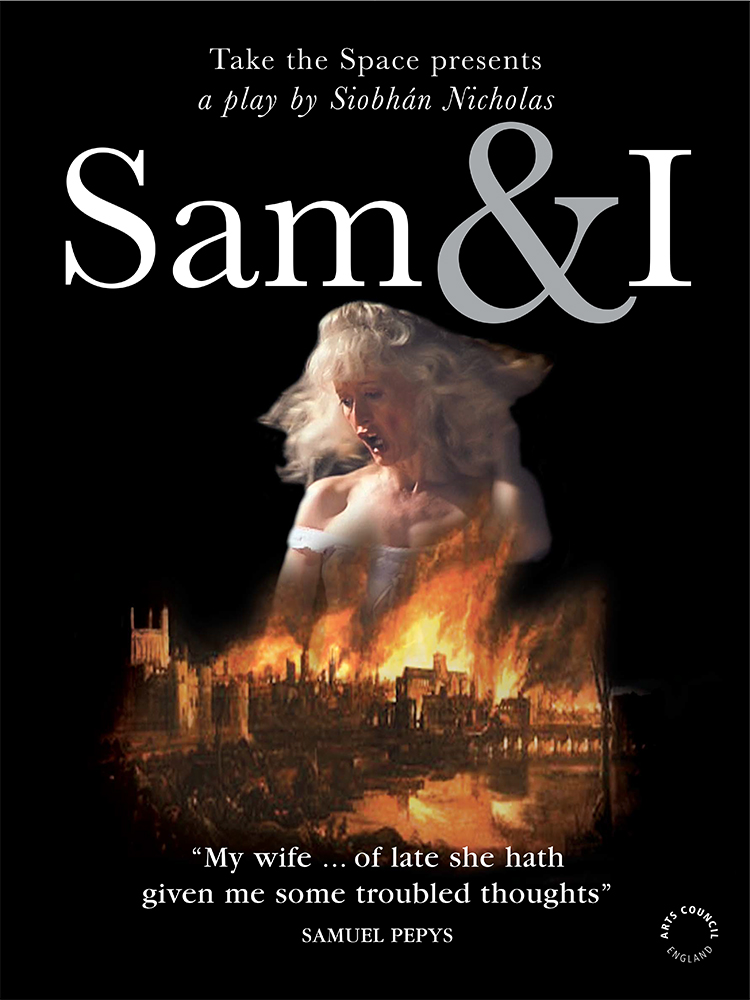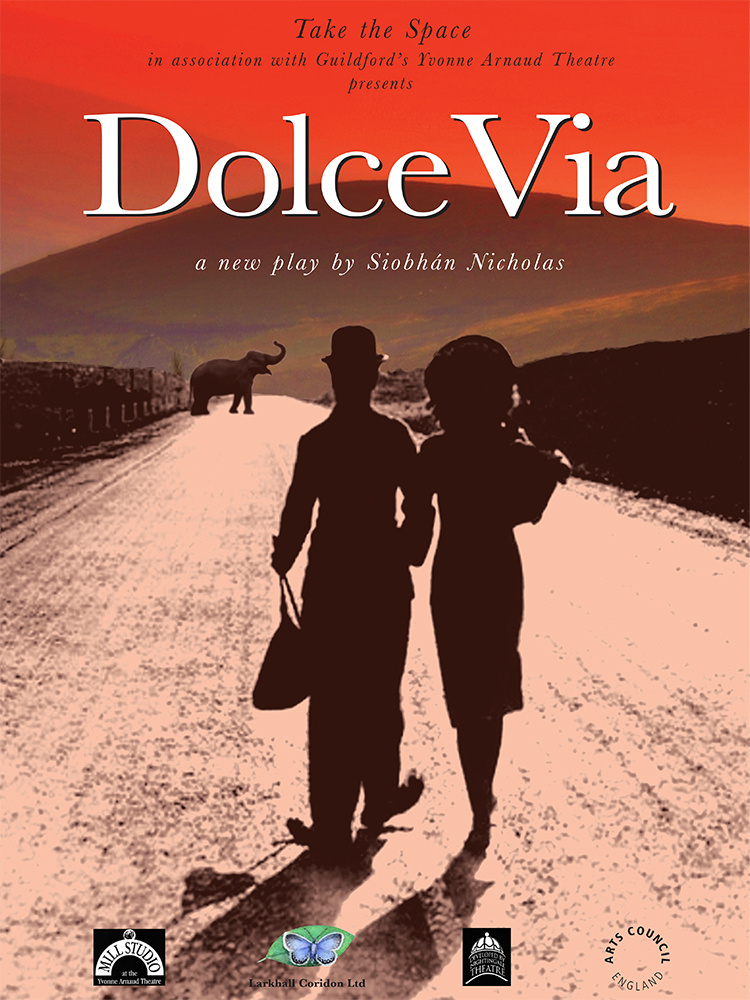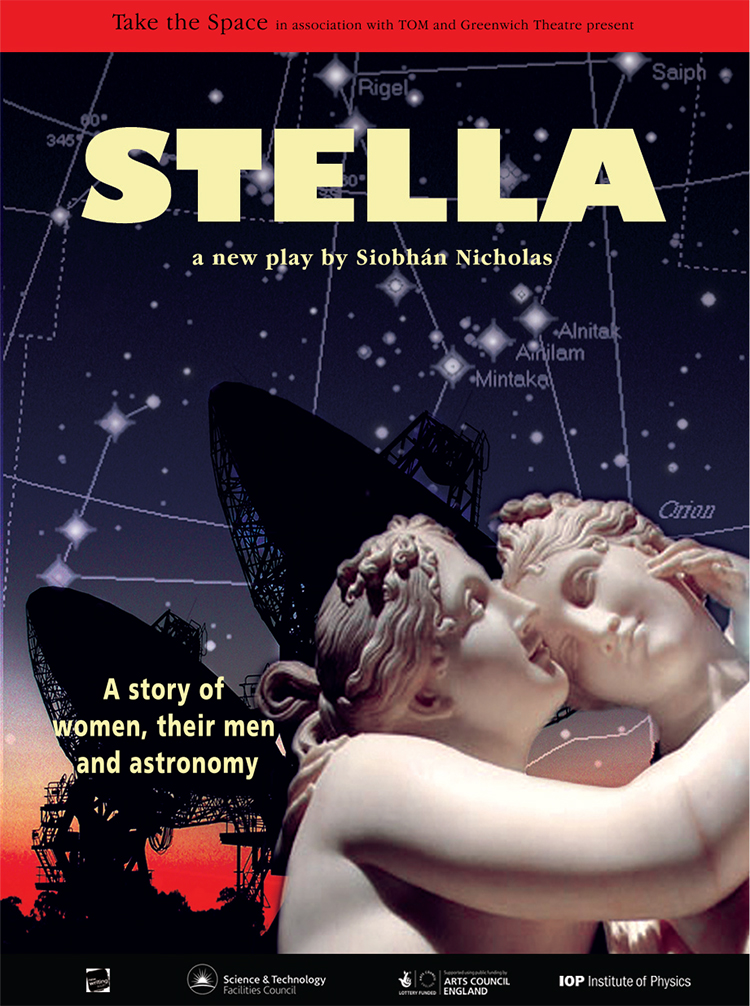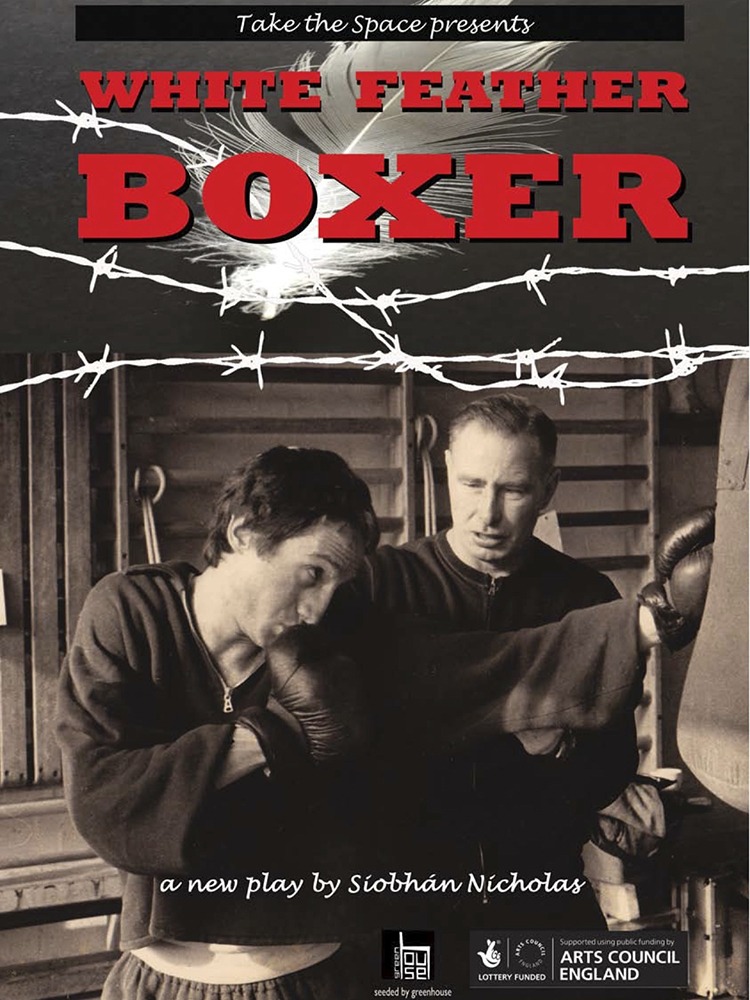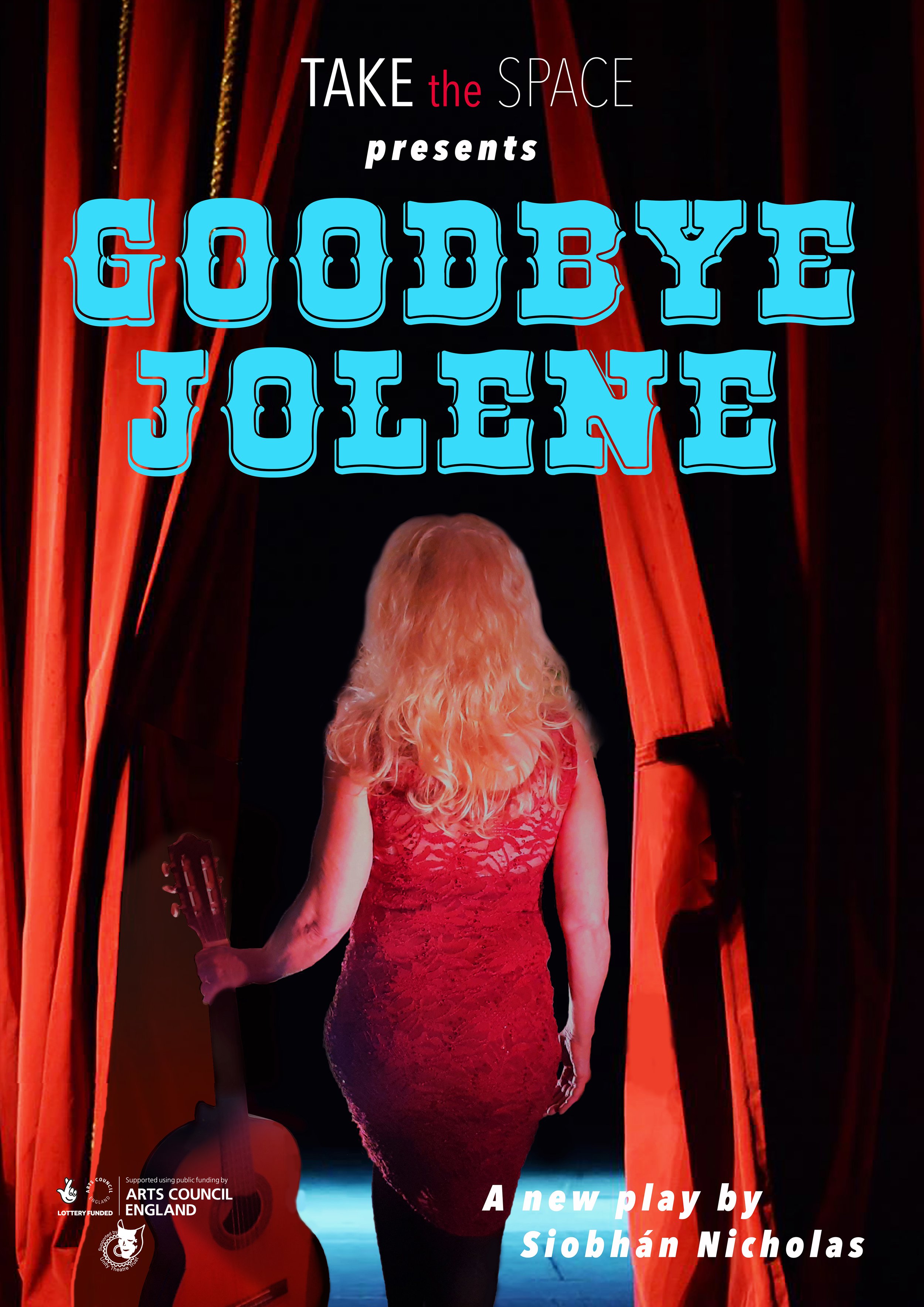Reviews for Take the Space's production of Hanging Hooke
Plays International
South East Round Up
Reviewer: Jeremy Malies
Eastbourne theatre-goers had a different experience at the Winter Garden with Siobhán Nicholas’ Hanging Hooke which concerns the polymath Robert Hooke (1635-1703), regarded by many as the English Leonardo.
A prodigy, he was making serious speculations about evolution in his early teens while observing fossils on the Isle of Wight. He would go on to propose the inverse square law for gravity and be treated shamefully by his contemporary Isaac Newton.
Hooke was the first person to use the word “cell” when referring to living matter and the first to report the rotation of Mars. He observed lunar craters, invented the thermometer, suggested a wave theory of light and considered whether its speed might be infinite. Combining chemistry and optics with architecture, he assisted his former school classmate Christopher Wren in rebuilding London after the Great Fire of 1665 and designed both the Greenwich Observatory and the ‘Bedlam’ Hospital.
Having gleaned a little information from preview blurb I trudged dutifully to this piece expecting a helping of poor man’s Michael Frayn, perhaps a clumsy seventeenth-century version of Copenhagen jumping on the current bandwagons of verbatim theatre and popular science.
The play is a reminder that as a regional theatre reporter you have to kiss a lot of frogs. This is the most wonderful piece of new writing I have seen in years. It is a one-hander performed by co-director Chris Barnes who has exceptional insight into Hooke, making him personable while stressing the towering nature of the subject’s intellect. Barnes is consistently impressive, showing first-rate technique when transforming himself from Hooke’s mentor, the portrait painter and miniaturist John Hoskins, into the scientist himself.
But it is the quality of the writing which deserves most praise. With arresting and disarming opening lines such as “Bloody civil war, it’s not a good time to travel!”, Siobhán Nicholas draws the audience into her world effortlessly. A notable optical engineer, Hooke describes the microscope as revealing “a honeycomb of tiny rooms” and this is an appropriate metaphor for Nicholas’ writing which is multi-layered but lucid at all times.
The playwright has an unerring eye for telling human details and picks them out against a background of the vast sweep of science. But she is rarely intrusive and like the painter Hoskins, soon immerses herself and the audience in the subject matter. The structure has a beguiling symmetry as Hoskins talks about his pupil and the scientist then recalls his one-time mentor. Hanging Hooke is about to tour nationally and most of the narrative cats should be left in the bag but I can say that an inspired use of voice over as the storyline comes out of its time frame and reaches a climax had me punching the air for joy.
The piece is funded by the Yvonne Arnaud Theatre, Guildford, and the New Vic. It benefits from a simple but credible set in which scientific instruments complement an enlarged image of Hooke’s manuscripts. Incidental music – some of it twentieth century – is chosen judiciously. The play is presented by Take The Space in association with Sussex-based New Vic Workshop whose recent Telstar transferred immediately from the south coast to the West End.
Not once does Siobhán Nicholas take an easy, lazy option in the writing. She has a gossamer touch with historical narrative and is linguistically inventive. Nicholas is also consistently witty as she toys with the audience’s prescience and lays out before us the path of physics right up to Einstein. This is an outstanding play.
British Theatre Guide
The Mill Studio at Guildford’s Yvonne Arnaud Theatre
Reviewer: Sheila Connor
In seventeenth century England there lived a man, one Robert Hooke, a contemporary of Isaac Newton and Christopher Wren and undoubtedly a genius to rival Leonardo da Vinci, yet he has been almost written out of history and forgotten - until now. This is his story.
The performer (Chris Barnes) stands motionless and listening as the voice of an auctioneer booms through the room describing a manuscript, the folio of Robert Hooke, for sale but with a reserve of one million pounds. Then, switching back in time, the play begins.
This man is not Hooke, but Jack Hoskins, who seems to be an amalgamation of three John Hoskins of the time, a miniaturist, a portrait painter, or perhaps Sir John Hoskins, the founder of the Royal Society where Hooke was employed for forty years as Curator of Experiments. This job perfectly suited his enquiring mind, his wide-ranging subjects covering science, engineering, architecture, the possibility of flight, the elasticity of air - the list goes on and on, “Robert Hooke is all around you”.
One experiment had him in a sealed vessel, from which the air was gradually pumped, and Barnes recreates the intense discomfort and pain of this by standing on his head while describing the effects on the body.
As Hoskins, Barnes takes us first from Hooke’s boyhood on the Isle of Wight to Westminster School where the boy’s first question is “Does the school have a lathe?” (something my engineer husband considers a possession no one should be without), later going on to Oxford.
Beginning as a friend and mentor, Hoskins’ regret and guilt is obvious when he seems to side with the rival Newton, but he so “loses himself in the world of his subject’ that he becomes Hooke and the performance is as intense and enthusiastic as if the man himself is standing before us describing his work. The intrigue, resentment and betrayal as others take credit for his discoveries are heartfelt, leading to his becoming reclusive and secretive, hiding the precious manuscript of his experiments in a trunk.
The friend, rival, then enemy who most upsets him is Newton whose theories of the gravitational pull of the planets are based on Hooke’s previous work, and a lighter note is his understandable annoyance when handed a newspaper to find headlined the story of the apple. Although his own name is mentioned, it is spelt incorrectly.
The floor of Lizzie Wyllie’s set resembles a hand-written manuscript with ‘tools of the trade‘ (or of Hooke’s experiments) surrounding the performer, and music or appropriate sound is used to emphasise the mood.
Together the writer and performer direct and obviously feel passionately about their subject, as well they might. Barnes is on stage addressing the audience for a full hour and a half without a break and his energy and earnestness never flags - an inspired performance to complement some exceptional writing.
As a ‘codicil’ to the story, in 2006 Hooke’s lost folio was discovered in a house in Hampshire, auctioned at Bonhams and, with thanks to the Wellcome Foundation and donors, has found its way back to the Royal Society where it belongs. It can be viewed on the internet.
Hooke also worked closely with his friend Christopher Wren on the Monument and St. Paul’s Cathedral, and today, at last, there is a plaque crediting his contribution, and a memorial tablet in St. Paul’s.
I would urge everyone to see this play: it is an education as well as an entertainment, exquisitely written and performed, and a tribute to the man who inspired it all.
Daily Info
Oxford Playhouse (Burton Taylor Studio)
Reviewer: Andrea Hopkins 14/03/08
This is an enthralling piece of theatre for two reasons. One, the subject matter is absolutely riveting – it tells the story of (almost) forgotten genius Robert Hooke, a polymath who included draughtsmanship, architecture, engineering, mathematics, and the emerging study of “natural philosophy” among the many interests and activities at which he excelled.
Born with a deformed spine and coming from a poorish family – his father was a country parson – he attracted mentors, got an excellent education, and was for many years the Curator of Experiments at the Royal Society. He was friends with and worked with the richer and better connected Boyle and Wren, but was never publicly rewarded in the same way, largely because of his famous and unedifying quarrels with Sir Isaac Newton, the éminence grise who blighted his hopes and, according to this play, nicked all his best ideas and passed them off as his own. Newton detested Hooke and did his best to eradicate him from history, destroying his portrait at the Royal Society (there is now no authentic image of Hooke) and he is only now receiving proper credit for all the important things he achieved.
The second reason is the performance of Chris Barnes. This is a one-man show and he is the man. I don’t think I’ve ever seen an actor work so hard for his living – he even delivered an entire speech while standing on his head at one point, which would be most impressive even in a fit young whippersnapper, but for a chap who’s not going to see fifty again and is probably sneaking up on sixty it was amazing. He looks a bit like Mervyn Peake’s drawing of Barquentine from Gormenghast – piercing eyes, a magnificently contoured nose reminiscent of Dartmoor, wild shoulder length grizzled hair.
He started out at Jack Hoskyns, Hooke’s first mentor and friend, who later betrayed him by acting as a spy for Newton because of his membership of the secret society of the Rosy Cross, then metamorphosed into Hooke himself. His telling of the story was a tremendously dynamic, agonized, energized performance – like the Ancient Mariner, he wanted you to know his story, needed you to listen so badly, the tension was palpable as the sweat poured down his face. At last, unburdened of his final revelation, he relaxed to the audience’s frantic applause. It was a really memorable hour and a half. The Burton Taylor Studio is small and the theatrical experience intimate, intense.
Rush out and get tickets now before it’s too late!
Eastbourne Herald
"Spell-binding Hanging Hooke"
Reviewer: Roger Paine
IT IS DIFFICULT to conclude which was the more enthralling. The life and times of Robert Hooke, 17th century inventor, microscopist, physicist, surveyor, astronomer, linguist, biologist, musician and artist who is the subject of this play written by Siobhan Nicholas, the fourth in the New Vic Workshop's Solo Season, or the riveting portrayal of this forgotten polymath by Chris Barnes, who also co-directed the play with Siobhan.
Few, if any, in the audience would have heard of Robert Hooke before seeing the play. Yet this crippled son of a curate born in 1635, went on to become Surveyor of the City of London after the Great Fire, and a Fellow and Secretary of the Royal Society. For 40 years in the Age of Enlightenment, Hooke rubbed shoulders with legendary figures such as Christopher Wren and Isaac Newton. Sometimes known as the 'English Leonardo da Vinci', his immense achievements were inspirational and long-lasting. Chris Barnes first introduces Hooke through the eyes of John Hoskins, an artist painting Hooke's portrait, who had befriended him during his boyhood on the Isle of Wight.
This sets the scene for Barnes' portrayal of Hooke himself. Long, dishevelled hair, gaunt-eyed and dressed in funereal black he limps mesmerizingly around the stage describing the qualities of springs and elasticity, the forces of gravity affecting the sun and planets or standing on his head to demonstrate an experiment in respiration. Intertwined with this gripping historical staging were original twenty-first century elements, including the voice of a Bonhams auctioneer in 2006 when Hooke's scientific manuscripts, 'lost' for 300 years, were estimated to fetch £4 million.
These contemporary touches, plus a pulsing heart-beat to signify the passage of time, combined seamlessly to create a spell-binding production.
Bournemouth Echo
The Lighthouse Poole
Reviewer: Jeremy Miles
In his day he was known as the English Leonardo. Robert Hooke was a home-grown genius who, in the late 17th century, briefly dazzled London’s scientific elite.
Christopher Wren was in awe of him but switched allegiance when rising star Isaac Newton made it clear that HE was the main man at the Royal Society.
At least that’s the way Siobhan Nicholas’ finely crafted one-man drama tells it. It finds actor Chris Barnes making compelling work of the story of the inspired artist, architect, engineer and physicist sidelined by jealous rivals.
Barnes appears first as Hooke’s turncoat friend, the artist Jack Hoskins, and then as Hooke himself.
It’s an astonishing performance which rewrites 17th century history as we know it. Many things are turned on their heads including at one point Mr Barnes himself. We learn that Hooke anticipated air travel and atomic theory and still found time to help Sir Christopher Wren build both St Paul’s and The Monument. Extraordinary.
Daily Info
Clwyd Theatr Cymry Mold, October 16, 2010
Reviewer: Victor Hallet
Robert Hooke was the renaissance man who provided Newton with crucial information about gravity, coined the word cell in biology, had some inkling of evolution, helped Wren design St Paul's and planned the Monument as a telescope.
So why isn't this polymath more widely known? Well he was not well-born, he had a hump and he was not a social animal. Also he had the misfortune to be wholly disliked by Newton who was not averse to stealing ideas and giving no credit. Indeed to take over Hooke's public position, namely Curator of Experiments for the Royal Society, and wipe him out of the Society records.
This fascinating figure, who is at last being publicly recognised for his amazing works, is brought to utterly convincing life in this absorbing one man play. But we do have to wait for him, Chris Barnes first shows him through the words of a boyhood friend who becomes variously his guardian, companion, champion, portraitist and betrayer but who does come good finally when he protects Hooke's detailed papers from destruction.
Then the actor slowly metamorphoses into the crippled scientist in such convincing style that it's almost as though an entirely new actor has arrived.
By the end we feel as though we have been in the presence of the man himself. This is a tour de force of memory and acting by Chris Barnes. It looks sumptuous and the joint direction of author and actor ensures that the play never seems static.
It is also one of those pieces of theatre where the audience learns while being entertained, enjoys while being enlightened.
What could so easily have been as dry as dust is actually a beautifully organised, well written and expertly acted play, at times as gripping as a good thriller.


